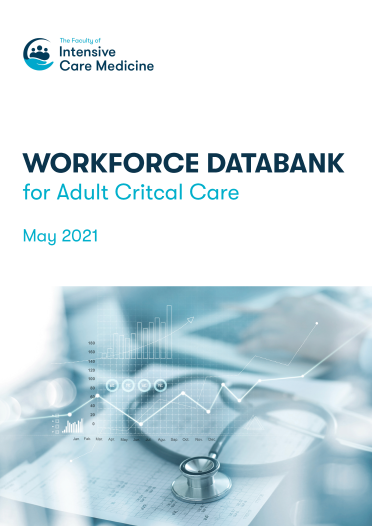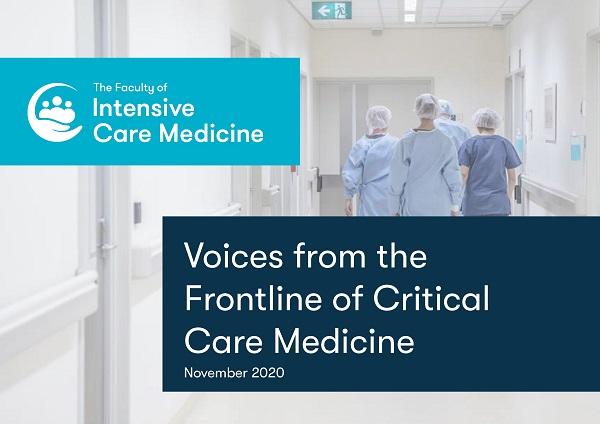Workforce data
The Workforce Data Bank for Adult Critical Care brings together all the key messages and key data sources on workforce for adult critical care. The Faculty’s Careers, Recruitment & Workforce Committee has utilised a number of data sources to prepare this workforce document, from FICM Census’ results, recruitment data, CCT output numbers and Consultant appointment data, to data from our critical care partner organisations.
The document has recently been updated to include 2019 and 2020 Faculty data for the Census, Recruitment and CCT numbers.
Why was it produced?
The Faculty of Intensive Care Medicine’s (FICM) Careers, Recruitment & Workforce (FICMCRW) has prepared a workforce data pack as a summary for Regional Advisors to use locally to support workforce and recruitment discussions since 2014. Following the recent Critical Engagements report the FICM recognised the essential role that all critical care doctors, nurses, practitioners and Allied Health Professionals have in championing the specialty and its workforce.
The original data pack has therefore been reworked as a public Data Bank and gives a useful summary of the current workforce data and challenges.
How can it be used?
The Faculty will use the resource in its interactions with both local and national and UK-wide healthcare stakeholders. Members of the critical care community are encouraged to use this in discussions with Health Board / Trust management and local commissioners as a standard evidence base for workforce issues. It ensures we are using the same data and same approach in all workforce discussions.
Our thanks to the UK Critical Care Nursing Alliance, CC3N and ACTACC for contributing sections of the Data Bank.
Voices from the Frontline of Critical Care
In October 2020, the Faculty surveyed our consultant Fellows and Members to find out about their experiences during the first wave of the COVID-19 pandemic. The results have been published in the report Voices from the Frontline of Critical Care.
Key Findings
- 45% of respondents have seen a permanent increase in the critical care capacity of their directorates. However, when asked if they consider any increase in capacity to be adequately staffed only 18% of respondents agreed.
- 60% of respondents reported that their units are still attempting to follow the Guidelines for the Provision of Intensive Care Services (GPICS) but 54% of respondents have seen some relaxation of those standards including to their medical staffing.
- 80% of respondents increased their working hours, and 71% report covering sick consultant colleagues. Future uncertainties affect the wellbeing of the Faculty’s fellows and members. How hospital structures support those working in critical care is vitally important for both recruitment and retention.
- 88% of respondents had leave cancelled. Work/life balance is extremely important. Whilst the vast majority of respondents were happy to deliver the needed increase in work in the first wave, to do this over subsequent waves of the pandemic becomes increasingly difficult for individuals and their family. Supporting professional activities and agreed job plans will be even more important in subsequent COVID-19 waves.
- Faculty fellows and members understood the impact the first wave of COVID-19 had on non-critical care staff, and hugely appreciated their response to the crisis. The flexible increase in staffing was so important for care, although the drop in GPICS standards underlines the need to increase the underlying critical care capacity, and the multi-disciplinary workforce.
Key Recommendations from the report
- GPICS standards exist for reasons of best care, safety and governance. Units should be attempting to adhere to them or working towards achieving them.
- Inability to meet GPICS standards needs to be brought to the attention of management structures within hospitals and plans for addressing deficiencies identified and implemented.
- Supporting and maintaining the wellbeing of critical care staff is vitally important. Not only for recruitment by attracting multi-disciplinary team members in, but also for their retention in the specialty. Staff must not be taken for granted and listening to the voices from the frontline is only the start of this process.
- Enhanced Care recommendations, written and promoted by the Faculty, will allow for greater flexibility in future responses to surges in demand as well as safer care for those needing a higher level of care. Critical Care Directorates should make the case widely within their hospitals for enhanced surgical and medical care.
Critical Capacity
The Faculty published a short research survey into critical care bed capacity in March 2018. The full report is available here and was covered in the Guardian and the Times.
The key messages
- 3/5 of units do not have a full critical care nursing complement.
- Of those affected, the vast majority considered that bed capacity was inevitably impacted leading to cancelled operations. Quality of care and even patient safety might be impacted.
- 2/5 of units have to close beds due to staffing shortages on at least a weekly basis. Only 14% of units did not have to close beds.
- 4/5 of units had to transfer patients due to lack of beds. With 21% units doing this at least monthly.
- The bed fill rate for Northern Ireland and Wales was estimated to be at least 95%. Scotland was 84%. NHS England data put the critical care bed capacity rate at 87%, but a number of units responded to express doubt that the rate entered for their Trusts was a true reflection of their real capacity.
Dr Carl Waldmann, Dean of the Faculty, said:
“The Faculty of Intensive Care Medicine recommends that the Departments of Health and each Health Board and Trust make modelling of critical care need and resources an urgent priority.”
Centre for Workforce Intelligence Report on Anaesthesia and ICM
This in-depth review of the anaesthetics and Intensive Care Medicine Workforce, published in February 2015, underscored the need for more investment in the ICM workforce. Findings included:
- HEE should continue to fill the current number of training posts for anaesthetists and intensivists in England to minimise the risk of short-term undersupply, with an appropriate mix of specialists with single and dual CCTs.
- Anaesthetists provide a notable level of service to ICM and that any changes to this provision would need to be counteracted with an increase in the provision of ICM.
- In line with ICNARC research on projected usage of Level 2 and 3 bed days, there is likely to be a significant increase in need, with most scenarios indicating that it is likely to double by 2033.
Related Content
Want to know more?
Visit our Careers Hub.


